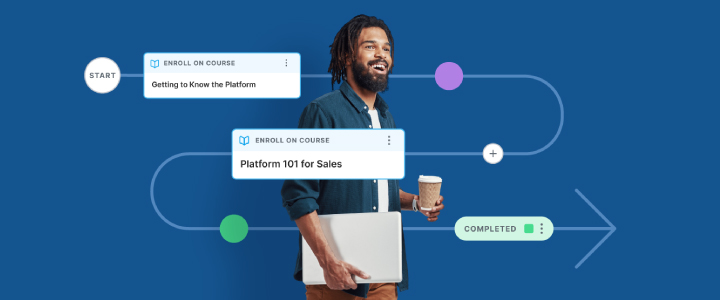
3 min reading time
What is Social Learning?
Social learning can be an incredibly effective way to encourage a company culture that prioritizes education, but its origin and components must be adequately understood in order to maximize its impact. For those of you who have wondered, “What is social learning?”, this post will provide an answer, and also offer specific ways to incorporate it into your L&D efforts.
Bandura’s social learning theory
Social learning originated with psychologist Albert Bandura’s “social learning theory.” During the 1960s, he conducted a series of experiments with children to gain a deeper understanding of how a variety of social factors play a role in learning. His findings showed the significance of “observing, modeling, and imitating the behaviors, attitudes, and emotional reactions of others.” In other words, humans frequently mirror the actions of those around them, whether or not they’re aware of it.
What is social learning?
Using social learning theory as a foundation, social learning embraces the fact that humans are social creatures to increase engagement and retention when structuring a formal educational curriculum. Social learning is a two-way, collaborative approach to learning that counters the traditional, top-down model. By maximizing opportunities to interact with others, social learning enables participants to observe and imitate the actions and behaviors of those around them, which is shown to be a much more impactful way to gain new skills.
Is social learning effective?
In a research snapshot that we recently published with Chief Learning Officer, we highlighted two primary motivations for companies to use social learning technologies. 56.6% of those surveyed agreed that social learning “created and supported a culture of learning”, and 40.1% said “it encouraged collaboration and innovation.” Given the substantial number of survey participants motivated by these positive results, it’s safe to assume that many organizations have found social learning extremely effective in helping them meet their learning goals and objectives.
Not only are an ever-increasing number of companies realizing the power of social learning, but the progression of technology has helped it become more accessible. Modern LMS platforms, many of which are designed for maximum learner engagement, often include elements of gamification, leaderboards, and other features that naturally lean into the social learning strategy. By showcasing top-performing peers, and even allowing them to demonstrate gained knowledge and skills, other participants are more likely to be motivated to continue down their own learning path.
LMS platforms also simplify the process required to revisit concepts and practice skills over time, which is another key way that social learning can help to increase retention. Since LMS platforms offer clear reporting around training history, topics, and participants, L&D teams can be intentional about which concepts they return to, and which skills have been sufficiently covered.
What is social emotional learning?
Anyone who plays a part in education and upskilling within their organization has likely come across the term “social learning”, and for good reason.
It’s worth noting that social learning and social learning theory shouldn’t be confused with “social emotional learning.” Often referred to by its acronym, SEL, social emotional learning is a group of behaviors and skills that have been identified as essential to succeed as a student.
How to measure the impact of social learning
As with all training efforts, the question of measuring impact is vital. Measurement also presents one of the most common challenges to the embrace of social learning. The social learning research snapshot that we referenced earlier also lists which metrics are most commonly used to measure the impact of social learning. The top three are:
- Increased Learner Engagement: 47%
- Transactional (System) Data: 39%
- Learner Satisfaction: 33%
Each of these metrics (and seven of the ten most common) are all qualitative in nature, which can be an obstacle to gaining support from certain leaders. That’s where the importance of educating leadership comes in, because the potential value of social learning far outweighs any quantitative shortcomings. In fact, as our research snapshot points out, “Social Learning is considered an integral component for strengthening the relationship between the organization and its employees.”
Social learning takes time
With so much going for it, it can be tempting to toss your existing L&D strategy to triple down on social learning. But, like many things within the world of learning and development, an iterative process will prove much more impactful.
Rather than immediately turning the world upside-down, look for opportunities to incorporate social learning into your existing training programs. Additionally, carefully review the answers to employee training surveys for an indication that social learning is already playing a part in your organization, or that it might be an effective way to address shortcomings. Ultimately, making use of this proactive lens is more likely to lead to lasting positive outcomes for your organization and employees.




